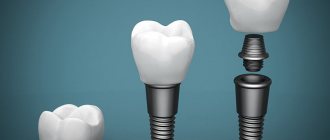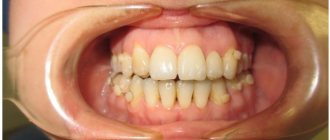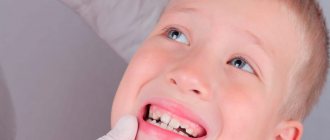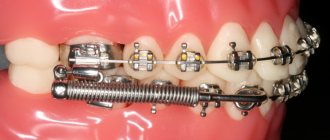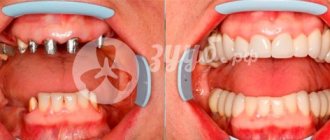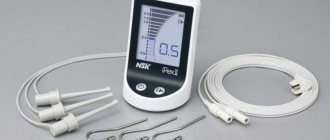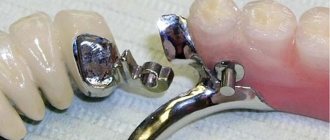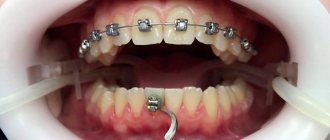18120
Dental problems make people of any age experience complexes.
Dental correction allows you to get rid of malocclusion and its consequences (periodontitis, enamel abrasion, tooth loss, diseases of the joints and gastrointestinal tract).
Braces are a modern way to treat dental anomalies in children, adolescents and adults.
To determine the most favorable time for orthodontic treatment, you should understand the physiological characteristics of the development of the dental-jaw system, and choose the best design according to your own individual criteria.
Installation of braces in adulthood
Orthodontic treatment with braces in Russia goes back about thirty years. And in the USA, for example, bite correction with braces has been practiced for more than a hundred years. Russian orthodontists today often work with adults who simply did not have the opportunity to undergo this level of treatment in childhood. As a rule, such patients themselves turn to the dentist, less often - through the referral of related specialists. As a rule, people come to orthodontists for a beautiful smile, and not because of any pain. Most of those applying are women. Men are more relaxed about imperfect smiles, although doctors have recently noted an increase in the number of male patients.
Plates for teeth: removable and non-removable
In dentistry, doctors work with different types of orthodontic products. At the initial appointment, the orthodontist will tell the young patient and his parents what the plates for straightening teeth are called, how they differ and what they are like. The most popular:
- systems – single-jawed, with a retraction arch, with a pusher, with a hand-shaped process;
- devices – Brückle, Frenkel;
- Andresen-Goipl activator.
Products are divided according to the method of fixation:
- removable – hypoallergenic polymer construction includes wire hooks and arcs for fixing the plate;
- non-removable – they look like metal brackets that put pressure on the teeth from the outside, forming the correct bite.
A removable dental plate is placed on children to correct simple bite defects. The optimal age of a child for correction is 5-12 years. Fixed products can compete in effectiveness with braces; they are usually recommended for teenagers to eliminate serious anomalies of the dentition.
Braces are non-removable orthodontic structures in which a plate is placed on each tooth, and an arch with a “memory effect” is responsible for correcting the bite. Metal braces are the most effective, but sapphire and ceramic braces are almost invisible on the teeth. There are also ligature braces with rubber bands and self-ligating ones, which reduce the treatment period by several months.
Does it make sense to get braces as an adult?
Correcting a pathological bite or incorrect position of teeth is, of course, not a matter of life and death. Rather, it is a matter of regaining self-confidence. The “curvature” of teeth has little effect on communication; after all, we perceive a person holistically, and not solely the state of his bite. But, you see, an open wide smile of any person will make him more attractive in our eyes. And only people who are not embarrassed to show off their teeth smile like that. Plus, when we talk about bite, it's not just about beauty, it's also about functionality. Nature intended that when chewing, the load on the teeth should be distributed evenly - this is only possible with straight teeth and a healthy bite. If this is not the case, then over time a person develops problems with the dental system: pain appears, clicks when opening and closing the mouth, etc. Therefore, orthodontic treatment for adult patients is not only possible, but also necessary.
Optimal age category
According to orthodontists of the “Smile” dental clinic network, the optimal period for correcting occlusion using braces is from 13 to 18 years. Treatment after adulthood is also effective, but takes longer.
The effectiveness of therapy depends not only on the patient’s age, but also on other associated factors:
- the complexity of a particular clinical case;
- physiological characteristics;
- correctly selected correction system;
- a person’s discipline associated with maintaining oral hygiene and timely visits to the clinic to adjust the orthodontic device.
At what age does it make sense for adults to get braces?
In any case, there are no age restrictions. There are surmountable obstacles: the general condition of the teeth, periodontal and gum diseases, and possible common concomitant diseases. Absolute contraindications for installing braces for adults coincide with many other types of treatment: lack of teeth, tuberculosis, diabetes, a number of immune diseases, epilepsy, bone pathologies, blood diseases. If a person gets braces when he is over thirty, the treatment will be quite long, since tissue regeneration occurs more slowly due to age. Plus, skeletal growth has already been completed, and the position of the bones can be “corrected” only when they are still growing - in childhood and adolescence. However, dentists achieve excellent results with mature patients.
Indications
When it is possible to put braces on a child, how can parents understand that he needs to correct the pathology of occlusion. Incorrect development of teeth and jaws becomes noticeable even in primary occlusion.
Signs to suspect that correction may be required:
- one or both parents have malocclusions;
- long-term disruption of nasal breathing;
- there are habits that can deform the dentition (finger sucking, foreign objects, prolonged pacifier sucking);
- visible dentition disorders;
- disproportionate development of the jaws;
- the child has diabetes and diseases of the nervous system.
In these cases, parents should take the student to an orthodontist for an examination. This is necessary to resolve questions about the advisability of correcting dental anomalies, installing braces for their children, and determining at what age it is best to start treatment.
Specifics of treatment with braces in adults
Adult patients should keep in mind that it is often necessary to remove teeth to achieve a high-quality result of orthodontic treatment. This does not mean that every patient needs it; removal is carried out only in cases where there is not enough space to restore the normal position of the teeth. Foreign orthodontists change the jaw size of adults using surgery. In Russia, orthognathic surgery is not yet particularly widespread due to the fact that our patients are extremely reluctant to agree to undergo operations. Let us repeat that this is just information about how it might be. In most cases, orthodontic treatment for adults is limited to simply installing braces.
What do children's dental plates look like?
A plate made in a pediatric dental laboratory is a standard of aesthetic perfection. Any shades, gradient colors, sparkles and bright decorations inside translucent plastic - children are delighted when they see it for the first time.
Structurally, the plate is:
- the base is strong and quite rigid;
- elastic wire - fasteners, arches and hooks are made from it, and it is this wire that provides the necessary pressure to correct the bite;
- the screw is an activator responsible for pressure and intensity of impact.
The screw is tightened by the doctor with a special key, or this is done by the parents according to the correction plan drawn up.
Soldatenkova Alina
I am often asked how dental plaques are made for children. First, we take impressions of the teeth – it doesn’t hurt, but sometimes it’s a little unpleasant. Then, based on the impressions, the appliance prescribed by the orthodontist is manufactured in a dental laboratory. Then try it on and create a design that is comfortable to wear. And issuing a plate to the patient with recommendations for wearing
Which braces are most often installed in adults?
It is most rational to choose metal braces: they are the most durable, and since the treatment will be long, this is one of the most important indicators. When it comes to minor corrections, aesthetic systems made of ceramics or artificial sapphires can be installed. But, let’s say, ceramic braces are quite fragile compared to metal ones. If the ceramic lock is chipped, you will need to remove it and install a new one. And this is a waste of time: when the lock is re-glued, the treatment can be considered to begin anew. When choosing a brace system, it is best to listen to the orthodontist’s recommendations - the doctor selects or combines types of structures so that the treatment is as comfortable as possible.
What problems may arise
Children are not able to maintain oral hygiene to the required extent. They do not take care of them, the structures may not last long, they break and the locks come unglued.
Other possible problems:
- Until the age of thirteen, children have soft and thin enamel. It is easily damaged when installing and wearing braces.
- The roots of the teeth are not yet strong. If the orthodontic structure is placed early, the roots may be destroyed and they will fall out.
- If correction systems are installed early, the teeth will become straight, but after they are removed as the jaw grows, curvature and discrepancy may occur again.
The question of at what age children get braces should be considered individually. Only an orthodontist can determine the age at which it is optimal for a child to have fixed structures installed based on individual indications and contraindications.
Is it possible to correct an adult's bite without braces?
You can - with the help of aligners. These are orthodontic transparent aligners made of solid polymer. Despite their rather simple appearance, aligners cope well with both minor changes in the position of the teeth and quite serious pathologies of the dentofacial apparatus. When treating with orthodontic aligners, patient motivation is extremely important. Aligners are more often chosen by men - they think that this type of treatment is less problematic. But they often lack patience and remove the aligners as soon as they feel discomfort. And this is unacceptable if the patient expects a positive effect of treatment. Aligners need to be worn 22 hours a day - keep this in mind before choosing this treatment option. If you comply with this requirement, then treatment with braces will not be necessary - mouthguards are no less effective at restoring the anatomically correct position of the teeth and correcting the bite.
Do veneers and lumineers correct malocclusion?
Veneers and Lumineers
– special porcelain, ceramic or composite overlays for teeth that mask external defects.
Veneers
Ultra-thin lumineers
The main difference between them is the thickness of the plate. Veneers are up to 0.6 mm thick and require grinding down the tooth surface before installation. Lumineers do not exceed 0.3 mm and do not require additional enamel treatment, but are not installed on large, protruding teeth.
Installing veneers on ground teeth
Patients often ask whether the bite can be corrected using this method. The overlays look aesthetically pleasing and do not require special care. But it is impossible to correct the bite with veneers or lumineers.
Plates do not correct occlusion defects. Their main task:
- align the shape and height of teeth;
- hide visible marks from fillings;
- mask crevices between teeth, cracks and chips of enamel.
Veneers and lumineers are not used for malocclusion; they are used only to mask aesthetic defects.
Advantages and disadvantages.
Using a plate, you can align your teeth in height and give your smile whiteness and radiance. They have no side effects, except for the need to grind off a small layer of protective enamel. Veneers and lumineers last a long time; made from high-quality materials, they will last on the teeth for up to 20 years.
Price.
The cost of one overlay is from 20 thousand rubles. A record made from the latest generation material will cost three times more.
What are the best “adult” braces according to reviews?
Most adult patients respond positively to lingual braces. They are fixed on the back surface of the teeth and are absolutely invisible to others. This type of braces has the lowest profile: the clasps of the systems are lower than all others, and therefore do not interfere with diction, do not irritate the mucous membranes, and do not scratch the tongue. Adults also often choose non-ligature ceramic braces - they are practically invisible, quite durable and cheaper than sapphire structures. When choosing a vestibular system that is fixed on the front surface of the teeth, it is worth considering that no matter what invisible material its clasps are made of, the orthodontic arch will always be noticeable. Therefore, you can safely choose classic metal braces. Ultimately, preference for a particular design comes down to its price.
Sapphire braces
Sapphire braces
Another type of aesthetic braces is sapphire. They are made from a special artificially grown sapphire that is transparent, crystalline and sparkling. Its properties are close to natural sapphire, it is highly durable and does not cause allergies at all.
Sapphire braces are similar to ceramic braces in many ways, but they have a significant difference. In certain lighting, they are much more visible on the teeth, as the light is reflected in the edges of the artificial crystals. At the same time, such visibility looks beautiful, turning braces from an ordinary device for correcting the bite into an elegant decoration.
There is no point in considering their advantages and disadvantages separately - they are almost completely identical to ceramic ones, except that they cost a little more, but at the same time they look more prestigious. In addition, not every clinic has the opportunity to install sapphire braces - metal and ceramic are much more common.
Retainers: why are they worn after braces are removed?
A retainer is a device that looks like an arch. It is placed on the back surface of the teeth when braces are removed. This way the new position of the teeth is secured. The ligamentous apparatus of the teeth has muscle memory, so no matter how we move the teeth, they will tend to return to their “original” position. Wearing a retainer is an essential part of orthodontic treatment. This is especially true for people over twenty-five years of age. A retainer is installed for at least two periods of wearing braces: for example, the patient wore them for one year, then the retainer will need to be worn for two years. Foreign orthodontists generally argue that you need to wear retainers constantly - this is the only way to guarantee that your teeth will remain straight. In general, after some time the retainer can be replaced with a night guard or plate. But some kind of structure supporting the new position of the teeth will definitely be needed - this is a classic. Unfortunately, patients often neglect this stage of treatment, experience relapses and begin to talk about the ineffectiveness and uselessness of orthodontic treatment in adulthood.
How to care for braces
Braces care
While wearing braces, you need to follow a lot of rules. This is necessary so that the treatment goes well, and after removing the braces, the patient does not experience caries or other dental problems.
The main thing in care is to follow six basic rules:
- Visit the dentist regularly to monitor the treatment process, professional cleaning, and replacement of structural elements. Visits are scheduled by the doctor himself, usually once every one to two months.
- Brush or at least rinse your teeth after every meal. Even if you snack on a sandwich, you need to find a way to immediately rinse your mouth to remove any leftover food. Otherwise, they can penetrate under the braces and quickly cause the destruction of the enamel.
- Use special devices for cleaning - brushes and irrigators. We will talk about them in more detail below.
- Thoroughly brush your teeth on all sides and do it correctly. Often people brush their teeth only from the outside, which leads to the formation of plaque and stone, which can cause inflammation and caries.
- Consult a doctor in case of any breakdowns of the brace system; do not try to glue braces or insert an arch on your own.
- Before brushing your teeth, you need to remove all the rubber bands and rods that are attached to the teeth to move the jaws relative to each other.
In addition to a regular brush, special tools and devices will be required to care for teeth with braces.
V-shaped toothbrushes
They are considered one of the most effective devices for cleaning teeth with braces. They differ from ordinary brushes in that in the center the bristles are shorter than at the edges, that is, a special recess is formed, just for braces. When cleaning, a regular brush simply glides over the braces and practically does not touch the enamel, but this one allows you to clean everything as thoroughly as possible.
In addition, short bristles clean locks better, and long bristles are good at cleaning out food debris from between teeth.
This brush can be used instead of a regular brush for regular cleaning. Teeth should be treated with sweeping movements, locks should be cleaned vertically, and the brush should only be moved from the gums to the edge of the teeth. The arc should also be cleaned, but only horizontally.
When brushing, you must use toothpaste, you can use regular toothpaste, preferably containing fluoride.
Mono-beam brushes
Regular brushes have many tufts of bristles on the head, while mono-tuft brushes have only one. The shape of this beam can be cut or slightly pointed. This bundle is not suitable for regular cleaning, but it does a good job of removing plaque between teeth.
When brushing, keep the brush at a 90-degree angle to your teeth. First you need to go in the gum area, then between the teeth, and then move on to cleaning the locks in a circular manner. This brush can be used not every time, but once a day or two.
Cleaners
Such designs are a small handle with nylon bristles. Brushes can be of different lengths, thicknesses and shapes - they need to be selected depending on which one is more convenient for the patient to use. You need brushes to clean the space under the arches and near the clasps. Brushes cannot be used regularly, but only if something gets under the braces.
Irrigators
An irrigator is a special device that delivers a stream of water under high pressure to the teeth. In general, it can be used without braces, but during orthodontic treatment it additionally helps to completely remove plaque. At the same time, the irrigator massages the gums, which prevents their inflammation.
You need to use the irrigator several times a week, after basic teeth cleaning.
How long should adults wear braces?
It is impossible to answer this question unambiguously: maybe one year, or maybe several years. Bite correction in adult patients is a long, labor-intensive process that requires patience and discipline. Therefore, orthodontists rarely persuade adults to straighten their teeth. If a person himself does not want this, then nothing will force him to conscientiously fulfill all the doctor’s demands. When treating adults with orthodontics, it is important that the dentist find a compromise between what he wants to achieve and what the patient wants to achieve. Orthodontists, of course, always strive to restore the perfectly aligned position of teeth, no matter how long it takes - at least three years, at least five years. The patient may get tired of the treatment and abandon it. The dentist’s main task is to honestly tell you how long the treatment will take and how it will proceed. And then hear whether the patient is ready to go this route.
Timing of correction
For teenagers and young people under 25 years of age, correction will take a year and a half. While an adult will have to wear braces to correct his bite and teeth twice as long, sometimes up to 5 years.
The duration of wearing products after 30 is longer for the following reasons:
- Slow metabolism.
- Stopping the growth of the dental-jaw system.
- Tissue regeneration is slow.
Because of this, adults have to change their dentition (sometimes with removal), and shift incorrectly positioned teeth using an orthodontic device.
A wide selection of braces designs allows each patient to choose the optimal solution for treating disorders.
At any age, the application of correction will be successful and highly effective, the only difference being how long it will take.
From the video you will learn about braces for adults.
Price of braces for adults in Moscow
To avoid misleading you, we will not indicate specific amounts. Because orthodontic treatment for adults is time-consuming and often requires additional or preparatory procedures, its overall cost cannot be low. But the opportunity to smile broadly without embarrassment is priceless at any age! Therefore, it makes sense to schedule a consultation with an orthodontist, no matter how old you are. After examination and research, the doctor will tell you the exact cost of treatment in your case.
Why do you need rubber bands when wearing braces?
Rubber bands or elastic bands connect the braces together in certain areas. They are needed to guide the teeth and create the necessary tension force. Tractions are used mainly for pronounced malocclusions to make treatment more effective and faster. The doctor will determine how long to wear elastic bands on braces: the time frame can vary from several weeks to several months.
Moving to another city is another difficulty in orthodontic treatment for adults
In the photo before and after braces, even a non-specialist can clearly see how the position of the teeth and the nature of the bite improve during the process of orthodontic treatment. But, unfortunately, the result of the correction sometimes leaves much to be desired, and this is not always due to the lack of qualifications of the dentist. In the case of older patients, problems often arise due to their frivolous attitude towards the extremely complex process of teeth straightening.
If the situation is such that a person moves to another city for family or work reasons, therapy is usually interrupted for an indefinite period, so the achieved result is quickly lost and the teeth move in different directions.

